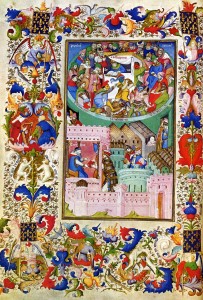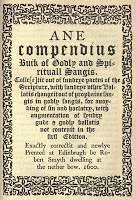
In June 2013, the full 5 hour version a Ane Pleasant Satyre of the Thrie Estaitis will be performed on the Peel at Linlithgow.
The research team gathered about a month into the project to discuss how this performance would be staged. Initial thoughts had concerned a ‘horseshoe’ configuration; several platform stages set up in a semi-circle, with the audience arrayed before them and the east side of the Palace providing the backdrop to the action. Such a configuration may well correlate to the 1554 performance of Satyre on the Greenside just outside Edinburgh. While the specifics of the staging of this performance are unknown, the topography of the playing area involved a steep hill with a burn or drainage ditch running through it, faced by a gentler slope on the other side . Sarah Carpenter suggests that the hill povided acoustic support for the actors playing in front of it, and that the audience were separated from the action by the burn – which is actually used during the performance – as they sat on the naturally ‘raked’ landscape behind it. The effect would have been similar to an outdoor proscenium arch theatre. The mode of staging during the 1554 performance was seemingly ‘place and scaffold‘ as certain main characters have named ‘seats’, meaning the rest of the characters would act in the undifferentiated area of the ‘feild’ mentioned during the play.
This configuration makes sense of the Greenside as a performance venue, but our ideas were adapted after several site visits and getting to know the grounds of Linlithgow a little better. The action involving the burn (John the Commonwealth ‘loups’ or jumps it, the workmens’ wives wade through it, and the Pardoner’s relics are thrown into it) would not be able to be replicated at the Palace which is ‘ditch-free’, so other features of the text took prominence. Paramount to Ane Satyre is the fact that key characters emerge from the audience; the Vices probably do in Part One, and John the Commonwealth and the Pauper certainly do in Part Two. This is not uncommon for sixteenth century interludes. Deriving from the morality play, a Vice’s entrance through the audience serves to remind them of how close they are sin and temptation.
In Satyre however, it is not only the Vices but the characters representative of the wider Scottish community who make their way to the stage via the audience. We looked at the limited number of examples of late medieval staging that survive including The Castle of Perseverance, The Martyrdom of St Apollonia, and one found in the Térence des ducs manuscript. All of these images showed some form of in-the-round staging. The Térence des ducs image was especially helpful as the very top of it demonstrates an enclosed playing area, and you can actually see the back of audience’s heads in the foreground of this theatrical space. While there is a wall rather than stages encircling this outdoor theatre (unlike the St Apollonia image), there is a central ‘scena’ – a pulpit-type area in which an actor is reading from a text – and costumed actors can be seen playing before it.
This set-up lends itself to the effect that we are trying to achieve with our audience; that they are auditors of a parliament whose decisions directly concern them, and that the speakers who represent their interests may be found among them. By staging Satyre in-the-round, the world of the play collapses with the play in the world, helping to make relevant social issues which are remote in time, but which stand in for a whole host of issues faced by Scottish people today also trying to get their voice heard. A crucial intervention to completely in-the-round staging was made by the team however, who thought that the area directly in front of the King should be cordoned off in some way, to demonstrate the inextricable nature of access to certain spaces and political authority or influence in the play. There was also the decision taken, for reasons of audibility and visibility, that there should be a central, elevated stage in the middle of the playing area, in the vein the Castle of the Castle of Perseverance, or the ‘scena’ in the Térence des ducs image.
Consultation with personnel at Historic Scotland will decide whether this form of staging is feasible, but for now the project team are excited about the surrounding of audience with stages on the Peel, truly marking them out as a political as well as a theatrical community during the performance of Ane Satyre of the Thrie Estaitis.








